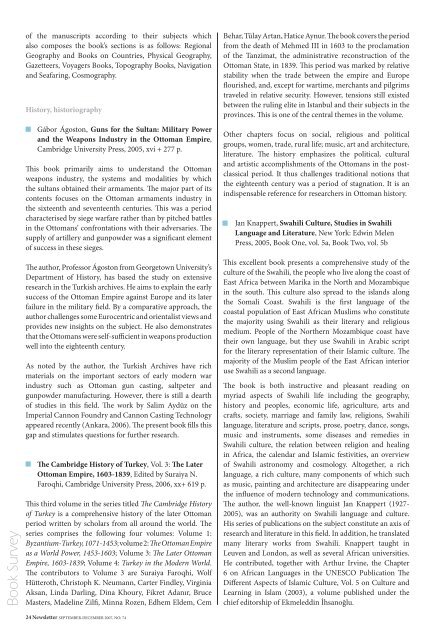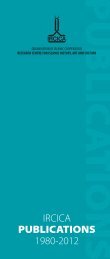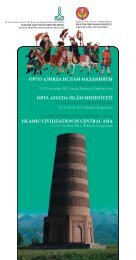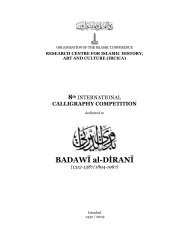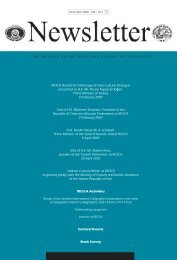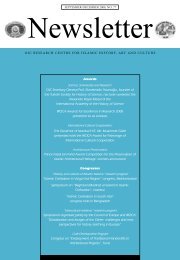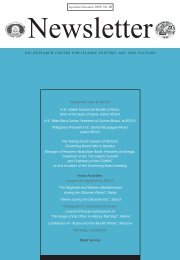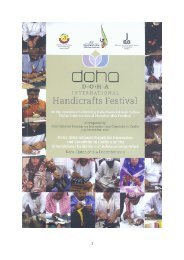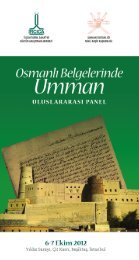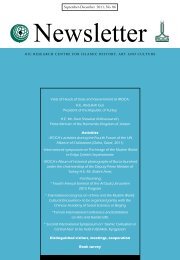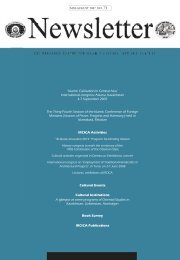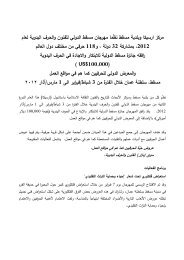oic research centre for islamic history, art and culture - ircica
oic research centre for islamic history, art and culture - ircica
oic research centre for islamic history, art and culture - ircica
- No tags were found...
You also want an ePaper? Increase the reach of your titles
YUMPU automatically turns print PDFs into web optimized ePapers that Google loves.
Book Surveyof the manuscripts according to their subjects whichalso composes the book’s sections is as follows: RegionalGeography <strong>and</strong> Books on Countries, Physical Geography,Gazetteers, Voyagers Books, Topography Books, Navigation<strong>and</strong> Seafaring, Cosmography.History, historiographyGábor Ágoston, Guns <strong>for</strong> the Sultan: Military Power<strong>and</strong> the Weapons Industry in the Ottoman Empire,Cambridge University Press, 2005, xvi + 277 p.This book primarily aims to underst<strong>and</strong> the Ottomanweapons industry, the systems <strong>and</strong> modalities by whichthe sultans obtained their armaments. The major p<strong>art</strong> of itscontents focuses on the Ottoman armaments industry inthe sixteenth <strong>and</strong> seventeenth centuries. This was a periodcharacterised by siege warfare rather than by pitched battlesin the Ottomans’ confrontations with their adversaries. Thesupply of <strong>art</strong>illery <strong>and</strong> gunpowder was a significant elementof success in these sieges.The author, Professor Ágoston from Georgetown University’sDep<strong>art</strong>ment of History, has based the study on extensive<strong>research</strong> in the Turkish archives. He aims to explain the earlysuccess of the Ottoman Empire against Europe <strong>and</strong> its laterfailure in the military field. By a comparative approach, theauthor challenges some Eurocentric <strong>and</strong> orientalist views <strong>and</strong>provides new insights on the subject. He also demonstratesthat the Ottomans were self-sufficient in weapons productionwell into the eighteenth century.As noted by the author, the Turkish Archives have richmaterials on the important sectors of early modern warindustry such as Ottoman gun casting, saltpeter <strong>and</strong>gunpowder manufacturing. However, there is still a de<strong>art</strong>hof studies in this field. The work by Salim Aydüz on theImperial Cannon Foundry <strong>and</strong> Cannon Casting Technologyappeared recently (Ankara, 2006). The present book fills thisgap <strong>and</strong> stimulates questions <strong>for</strong> further <strong>research</strong>.The Cambridge History of Turkey, Vol. 3: The LaterOttoman Empire, 1603-1839, Edited by Suraiya N.Faroqhi, Cambridge University Press, 2006, xx+ 619 p.This third volume in the series titled The Cambridge Historyof Turkey is a comprehensive <strong>history</strong> of the later Ottomanperiod written by scholars from all around the world. Theseries comprises the following four volumes: Volume 1:Byzantium-Turkey, 1071-1453; volume 2: The Ottoman Empireas a World Power, 1453-1603; Volume 3: The Later OttomanEmpire, 1603-1839; Volume 4: Turkey in the Modern World.The contributors to Volume 3 are Suraiya Faroqhi, WolfHütteroth, Christoph K. Neumann, C<strong>art</strong>er Findley, VirginiaAksan, Linda Darling, Dina Khoury, Fikret Adanır, BruceMasters, Madeline Zilfi, Minna Rozen, Edhem Eldem, CemBehar, Tülay Artan, Hatice Aynur. The book covers the periodfrom the death of Mehmed III in 1603 to the proclamationof the Tanzimat, the administrative reconstruction of theOttoman State, in 1839. This period was marked by relativestability when the trade between the empire <strong>and</strong> Europeflourished, <strong>and</strong>, except <strong>for</strong> w<strong>art</strong>ime, merchants <strong>and</strong> pilgrimstraveled in relative security. However, tensions still existedbetween the ruling elite in Istanbul <strong>and</strong> their subjects in theprovinces. This is one of the central themes in the volume.Other chapters focus on social, religious <strong>and</strong> politicalgroups, women, trade, rural life; music, <strong>art</strong> <strong>and</strong> architecture,literature. The <strong>history</strong> emphasizes the political, cultural<strong>and</strong> <strong>art</strong>istic accomplishments of the Ottomans in the postclassicalperiod. It thus challenges traditional notions thatthe eighteenth century was a period of stagnation. It is anindispensable reference <strong>for</strong> <strong>research</strong>ers in Ottoman <strong>history</strong>.Jan Knappert, Swahili Culture, Studies in SwahiliLanguage <strong>and</strong> Literature, New York: Edwin MelenPress, 2005, Book One, vol. 5a, Book Two, vol. 5bThis excellent book presents a comprehensive study of the<strong>culture</strong> of the Swahili, the people who live along the coast ofEast Africa between Marika in the North <strong>and</strong> Mozambiquein the south. This <strong>culture</strong> also spread to the isl<strong>and</strong>s alongthe Somali Coast. Swahili is the first language of thecoastal population of East African Muslims who constitutethe majority using Swahili as their literary <strong>and</strong> religiousmedium. People of the Northern Mozambique coast havetheir own language, but they use Swahili in Arabic script<strong>for</strong> the literary representation of their Islamic <strong>culture</strong>. Themajority of the Muslim people of the East African interioruse Swahili as a second language.The book is both instructive <strong>and</strong> pleasant reading onmyriad aspects of Swahili life including the geography,<strong>history</strong> <strong>and</strong> peoples, economic life, agri<strong>culture</strong>, <strong>art</strong>s <strong>and</strong>crafts, society, marriage <strong>and</strong> family law, religions, Swahililanguage, literature <strong>and</strong> scripts, prose, poetry, dance, songs,music <strong>and</strong> instruments, some diseases <strong>and</strong> remedies inSwahili <strong>culture</strong>, the relation between religion <strong>and</strong> healingin Africa, the calendar <strong>and</strong> Islamic festivities, an overviewof Swahili astronomy <strong>and</strong> cosmology. Altogether, a richlanguage, a rich <strong>culture</strong>, many components of which suchas music, painting <strong>and</strong> architecture are disappearing underthe influence of modern technology <strong>and</strong> communications.The author, the well-known linguist Jan Knappert (1927-2005), was an authority on Swahili language <strong>and</strong> <strong>culture</strong>.His series of publications on the subject constitute an axis of<strong>research</strong> <strong>and</strong> literature in this field. In addition, he translatedmany literary works from Swahili. Knappert taught inLeuven <strong>and</strong> London, as well as several African universities.He contributed, together with Arthur Irvine, the Chapter6 on African Languages in the UNESCO Publication TheDifferent Aspects of Islamic Culture, Vol. 5 on Culture <strong>and</strong>Learning in Islam (2003), a volume published under thechief editorship of Ekmeleddin İhsanoğlu.24 Newsletter SEPTEMBER-DECEMBER 2007, NO: 74


